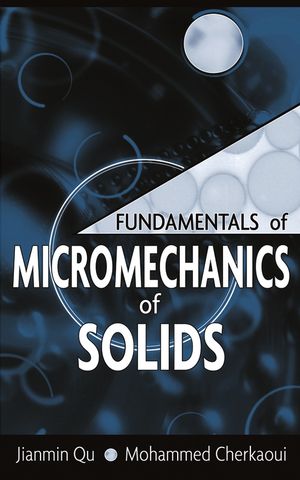Fundamentals of Micromechanics of SolidsISBN: 978-0-471-46451-8
Hardcover
386 pages
August 2006
 This is a Print-on-Demand title. It will be printed specifically to fill your order. Please allow an additional 10-15 days delivery time. The book is not returnable.
|
||||||
1 Introduction.
1.1 Background and Motivation.
1.2 Objectives.
1.3 Organization of Book.
1.4 Notation Conventions.
References.
2 Basic Equations of Continuum Mechanics.
2.1 Displacement and Deformation.
2.2 Stresses and Equilibrium.
2.3 Energy, Work, and Thermodynamic Potentials.
2.4 Constitutive Laws.
2.5 Boundary Value Problems for Small-Strain Linear Elasticity.
2.6 Integral Representations of Elasticity Solutions.
Problems.
Appendix 2.A.
Appendix 2.B.
Appendix 2.C.
References.
Suggested Readings.
3 Eigenstrains.
3.1 Definition of Eigenstrains.
3.2 Some Examples of Eigenstrains.
3.3 General Solutions of Eigenstrain Problems.
3.4 Examples.
Problems.
Appendix 3.A.
Appendix 3.B.
References.
Suggested Readings.
4 Inclusions and Inhomogeneities.
4.1 Definitions of Inclusions and Inhomogeneities.
4.2 Interface Conditions.
4.3 Ellipsoidal Inclusion with Uniform Eigenstrains (Eshelby Solution).
4.4 Ellipsoidal Inhomogeneities.
4.5 Inhomogeneous Inhomogeneities.
Problems.
Appendix 4.A.
Appendix 4.B.
Suggested Readings.
5 Definitions of Effective Moduli of Heterogeneous Materials.
5.1 Heterogeneity and Length Scales.
5.2 Representative Volume Element.
5.3 Random Media.
5.4 Macroscopic Averages.
5.5 Hill’s Lemma.
5.6 Definitions of Effective Modulus of Heterogeneous Media.
5.7 Concentration Tensors and Effective Properties.
Problems.
Suggested Readings.
6 Bounds for Effective Moduli.
6.1 Classical Variational Theorems in Linear Elasticity.
6.2 Voigt Upper Bound and Reuss Lower Bound.
6.3 Extensions of Classical Variational Principles.
6.4 Hashin–Shtrikman Bounds.
Problems.
Appendix 6.A.
References.
Suggested Readings.
7 Determination of Effective Moduli.
7.1 Basic Ideas of Micromechanics for Effective Properties.
7.2 Eshelby Method.
7.3 Mori–Tanaka Method.
7.4 Self-Consistent Methods for Composite Materials.
7.5 Self-Consistent Methods for Polycrystalline Materials.
7.6 Differential Schemes.
7.7 Comparison of Different Methods.
Problems.
Suggested Readings.
8 Determination of the Effective Moduli—Multiinclusion Approaches.
8.1 Composite-Sphere Model.
8.2 Three-Phase Model.
8.3 Four-Phase Model.
8.4 Multicoated Inclusion Problem.
Problems.
Appendix 8.A.
Appendix 8.B.
Appendix 8.C.
References.
Suggested Readings.
9 Effective Properties of Fiber-Reinforced Composite Laminates.
9.1 Unidirectional Fiber-Reinforced Composites.
9.2 Effective Properties of Multilayer Composites.
9.3 Effective Properties of a Lamina.
9.4 Effective Properties of a Laminated Composite Plate.
Problems.
Appendix 9.A.
References.
Suggested Readings.
10 Brittle Damage and Failure of Engineering Composites.
10.1 Imperfect Interfaces.
10.2 Fiber Bridging.
10.3 Transverse Matrix Cracks.
Problems.
Appendix 10.A.
References.
Suggested Readings.
11 Mean Field Theory for Nonlinear Behavior.
11.1 Eshelby’s Solution and Kro¨ner’s Model.
11.2 Applications.
11.3 Time-Dependent Behavior of Polycrystalline Materials: Secant Approach.
Problems.
References.
12 Nonlinear Properties of Composites Materials: Thermodynamic Approaches.
12.1 Nonlinear Behavior of Constituents.
12.2 Effective Potentials.
12.3 The Secant Approach.
Problems.
Suggested Readings.
13 Micromechanics of Martensitic Transformation in Solids.
13.1 Phase Transformation Mechanisms at Different Scales.
13.2 Application: Thermodynamic Forces and Constitutive Equations for Single Crystals.
13.3 Overall Behavior of Polycrystalline Materials with Phase Transformation.
Problems.
References.
Suggested Readings.
Index.



